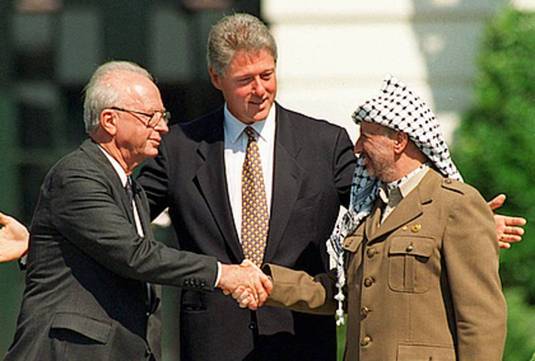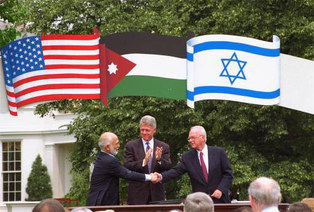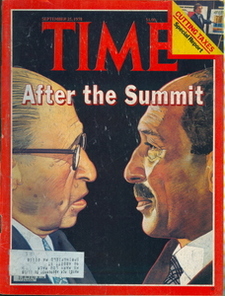A Leap Towards Peace
A Precursor to the Oslo Accords
The Accords demonstrated the possibility of peace that had eluded the Middle East for decades. They demonstrated that political will, the need for peace, and U.S. involvement could effect positive change. It laid the foundation for Clinton's brokering of the Oslo Accords.
"Oslo sketched out a peace process with a two-phase timetable. During a five-year interim period, Oslo envisioned a series of step-by-step measures to build trust and partnership. Palestinians would police the territories they controlled, cooperate with Israel in the fight against terrorism, and amend those sections of the Palestine Liberation Organization (PLO) charter that called for Israel's destruction. Israel would withdraw almost entirely from Gaza, and in stages from parts of the West Bank. An elected Palestinian Authority would take over governance of the territories from which Israel withdrew." (PBS) |
|
Further Peace Treaties
|
Camp David only eased tensions between Israel and Egypt, but the bold moves taken at that time laid the groundwork for future peace.
Negotiations at Camp David had long-term impacts beyond just the Oslo Accords. The 1994 Israel-Jordan Peace Treaty was also inspired by the diplomatic success at Camp David. "Israeli Prime Minister Yitzhak Rabin and King Hussein of Jordan formally made peace at a ceremony in desert area of Wadi Araba on the Israeli-Jordanian border. |
"Under the agreement, Israel and Jordan agreed to exchange territory and make the border conform to geographical landmarks.The treaty [1994 Israel-Jordan Treaty] opens the way for co-operation in trade, tourism, transport links, water resources and environmental protection. It also secures the Israel's longest land border." (BBC)
A Lasting Peace?
|
Since the Accords, Egypt and Israel have not had major conflicts.
"It proves that with good faith and some courage on both sides and with strong support and encouragement from the United States of America, particularly at the highest level, that very difficult problems in the Middle East can be overcome, that Israel and its neighbors can negotiate successfully an agreement for peace that is mutually beneficial and that it can last for a long time. As a matter of fact, the treaty that we worked out between Israel and Egypt, not a single word of it has ever been violated on either side." (Jimmy Carter) Further:
"We now take for granted that for more than 30 years there has been no war between Egypt and Israel but that's quite an achievement. If there's anything that I'm proud of in the Camp David Accords it's that we have helped to prevent what would have most certainly been another outbreak of a major war if they hadn't reached an agreement. The disappointment, and we knew it at that time, was that this would bring in the other belligerent parties, the Syrians, Palestinians, and others." (Interview: William Quandt) |
|
By opening the door to future peace treaties, the Camp David Accords were truly a turning point in U.S. involvement in Middle Eastern affairs.




